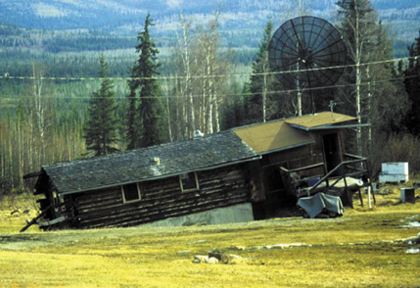 Over the
past 50 years, 21 tundra lakes near Council, Alaska, have shrunk dramatically
in area, damaging key habitats for migrating birds. The permafrost that holds
up the lakes is degrading, causing lake water to slowly drain down through the
soil to the water table.
Over the
past 50 years, 21 tundra lakes near Council, Alaska, have shrunk dramatically
in area, damaging key habitats for migrating birds. The permafrost that holds
up the lakes is degrading, causing lake water to slowly drain down through the
soil to the water table.Once-frozen soil thawed under this house in Alaska, allowing the house to settle. Evidence shows that the Arctic is rapidly warming. Although this settling may have resulted from poor design, many civil structures in Alaska are at risk now because their pre-1970s design criteria used climate data from a colder period.
According to Larry Hinzman of the University of Alaska at Fairbanks, the oil prospectors and bird populations are both experiencing effects from the same root cause — a rapid warming in the Arctic Circle. Photo courtesy of Larry Hinzman, University of Alaska at Fairbanks.
“The arctic system may be entering a state not seen in recent history, at least in the past 400 years,” he says. “And the increase in the rate of change is unprecedented, even over geologic time.” According to researchers at the University of Colorado at Boulder (CU), the total area of surface melt on the Greenland Ice Sheet reached the highest rates in 2002 in the 24-year satellite record, and the extent of arctic sea ice reached its lowest level in the area’s satellite record.
These dramatic results, presented at the fall meeting of the American Geophysical Union in San Francisco last month, came on the heels of a climate change workshop held in Washington the previous week. The Bush administration sponsored the workshop to get feedback from the scientific community on how to shape a national climate change policy. Hinzman says the message he would like the administration to get is simple: “Climate is changing in the Arctic.”
Mark Serreze, a researcher at CU’s Cooperative Institute for Research in Environmental Science (CIRES), says that 2002 saw the lowest sea-ice record in the Arctic since the early 1950s and possibly for centuries. His work discusses this past summer’s unusually warm temperatures and stormy activity in the Arctic Ocean. The Arctic Oscillation, a large-scale atmospheric circulation pattern, might be partially to blame. In its positive phase in the winter, the oscillation fosters ice break-up along the coast, preconditioning the area for summer ice loss. The oscillation has been stuck for decades in a strong positive phase, and the pet theory now for why, Serreze says, places the responsibility on ozone depletion — yet another piece of evidence, he adds, that humans are playing a part in the changes in the Arctic.
“Certainly there’s natural variability, but at some point you’ve got to step back and say things are really changing and they’re changing over a fairly long time period, which is consistent with the theories we have on climate warming and consistent with the models of changes we can see from carbon dioxide and other greenhouse gases,” Serreze says.
“If you put all the pieces together, they add up and the sum is the cause,” says CIRES climatologist Konrad Steffen, a professor in geography and atmospheric and ocean sciences at CU. That cause, Steffen says, is likely a combination of natural variability and human influences.
Steffen and his team found an increasingly higher melting at the surface of the Greenland Ice Sheet every year since 1979, except in 1991 after Mount Pinatubo’s volcanic eruption. The significance of the surface melting, Steffen explains, is not that it will create an increase in sea level. It’s that it will introduce freshwater into the ocean. “What we do worry about is that when an ice sheet thins dynamically, it pushes out a lot of ice into the ocean that melts,” he explains. Over the past 75,000 years, melting after massive iceberg releases called Heinrich events may have introduced large amounts of freshwater into the salty ocean, in turn changing ocean circulation patterns. Although researchers have linked these events to long-term cooling trends, Steffen says, the point is that these events triggered rapid global climate change, on time-scales of only a few years.
Steffen adds that the soon-to-be launched NASA ICESat instrument will help him and other researchers further understand the changes occurring across Greenland and the processes that might shape future climate changes.
Lisa M. Pinsker

